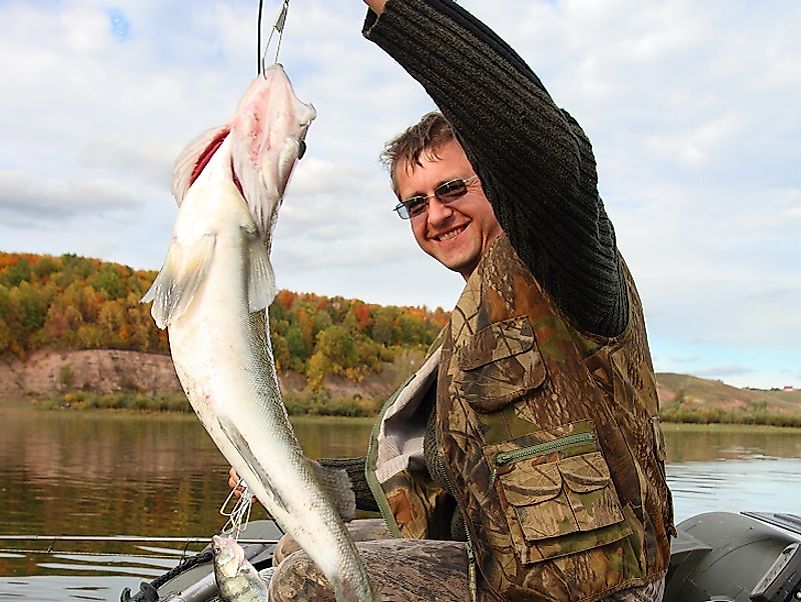Native Fish Species Of Russia

Russia is the largest country in the world, occupying more than one eighth of the world's total land area. Its capital and largest city is Moscow, and Russian is the official language. Russians are the single largest ethnic group at around 81% of the entire population. Russia is rich in biodiversity with 266 mammal species and 780 bird species. There is also a wide range of fish in the country with some being native while were introduced. In this article, we will discuss the native fish. These include the Abrau sprat, Baltic sculpan, Zander, white-finned gudgeon, Caspian kutum, and Amur sturgeon Sprat.
Abrau Sprat
The scientific name is Clupeonella abrau. The Abrau Sprat is a relatively small fish only found in Lake Abrau which is located at an elevation of 210 feet above sea level near the Black Sea. The fish is fairly small with the largest one ever recorded being slightly over three inches. They mainly feed on crustaceans while the young ones feed mostly on eggs and plants. The fish practices external fertilization and require only half a day to develop. The eggs are very small with only 1.1 millimeters and require a temperature of twenty-two degrees.
Baltic Sculpan
The Baltic Sculpan lives in fresh water and is mainly found in the Dniester Drainage Basin of the Black Sea. Its scientific name is Cottus Microstomus. It has a large head with sponge-like bony horns on the top with a big mouth. The ends of the fins are sharp and can be used for safe-defense. They are gray in color with a white abdomen. The females are larger than males with females weighing up to 1,700 pounds and measures up to ten inches.
Zander
The Zander is closely related to the perch, and resembles a pike with its elongated body and mouth. It is a relatively big fish weighing up to 44 pounds and has an average length of 31 inches. The Zander fish is considered as one of the most valuable foods in Russia and has a light, firm but tender meat which is highly delicious and has few bones. It is very unusual for Zanders to attack humans but, when they do, the results can be lethal. In 2000, a Zander measuring 3 feet long attacked tourists in Switzerland leaving two people critically injured with one receiving a cut three inches deep. Reproduction starts at the end of April. The females lay eggs in a nest made by the male in a hard bottom of gravel or sand after which the male guards the nest fanning the eggs to keep them clean from fine silt. The male also provides the eggs with oxygen until they hatch. The larvae and the young fish stay in the open water.
Caspian Kutum
As the name suggests, the fish is endemic to the Caspian Sea and is locally known as the Kutum in Russia. It is a freshwater fish with an average length of twenty inches and can weigh up to 11 pounds. The population is swiftly dwindling due to overfishing and also water pollution. Their preferred food is mollusks, amphipods, and crabs. The larvae and smaller fish feed on diatom algae and larvae of copepods. Caspian kutum lives in small schools usually in deep water apart from April to May where they move to shallow waters for spawning. The eggs are laid in gravel and hatch in around ten days with the fish becoming sexually mature after four years.
Amur Sturgeon
They have grayish-brown backs and pale ventral sides. They are big fish weighing up to 400 pounds and ten feet in length. In Russia, they are mainly found in the Amur water basin which stretches to China, but their presence in Japan is yet to be confirmed. The International Union for the Conservation of Nature (IUCN) classifies the species as "critically endangered", mainly due to water pollution. Because of their scarcity, they are highly priced on the market. They are freshwater fish with adults being found mainly in rivers with stony bottoms and mainly feed on benthic organisms. Reproduction occurs at least after every four years.
Native Fish Species Of Russia
| Native Fish of Russia | IUCN Classification |
|---|---|
| Abrau sprat | Critically Threatened |
| Baltic sculpin | Least Concern |
| Zander | Least Concern |
| White-finned gudgeon | Least Concern |
| Caspian kutum | Least Concern |
| Vobla | Least Concern |
| Kaluga | Critically Threatened |
| Amur sturgeon | Critically Threatened |
| Azov Percarina | Least Concern |
| Nelma | Least Concern |











